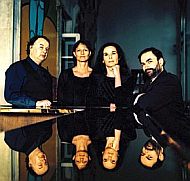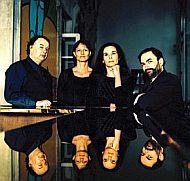
The Mosaïques players (Erich Höbarth and Andrea Bischof, violins; Anita Mitterer, viola; and Christophe Coin, cello) met as members of Nikolaus Harnoncourt’s Concentus Musicus Wien in the 1980s. Since then they’ve recorded a considerable swath of the 18th- and early-19th-century quartet literature, including the mature Mozart quartets, several dozen Haydn quartets, and Beethoven’s Op. 18. Early Mendelssohn is as far as they’ve ventured on disc, but recent performances (not here, alas) have included music as late as Bartók and Webern.
The quartet’s sound is not what people have come to expect of historical instruments. Partly that’s a consequence of a way of talking about historical performance that emphasizes the brisk and the brusque. “Early musicians” are always, journalistically speaking, scouring the grime off old masterpieces, forcing audiences to sit up in their seats, making all new and fresh and startling. When they take the liberty to be free, languid, or luxurious, it doesn’t make such good copy. (This is why, for example, many people think “period instrument” performances are always faster than “modern” ones, which is far from true.)
But partly it’s a real question of emphasis. Gut-strung instruments and “modern” ones vary greatly in terms of sound and response. A gut violin “E” string is (in my own playing experience) a cantankerous thing — harder to make sound, more perilous to strike quickly, and altogether more dangerous to play on than the steel “E” strings that have been standard equipment for violinists these last 70 years or so.
Such a string doesn’t sound so glassy and metallic as a steel “E,” but it takes a kind of effort to make it speak that you don’t have to expend with a steel string. And that sense of effort, of physicality, is something that’s become a part of period-instrument string playing. When you hear a fine “period” string section, a good part of the pleasure in it is just the “chiff” in the bowing — the little catch as the bow changes direction, the sense of the physical contact of bow and string that’s one of the things good “modern” string teachers try early to erase from their students’ playing.
Yet there’s another side to gut strings. Nothing is as silkily smooth as a gut-strung instrument subtly played. And there’s a way of coaxing sound out of a string, rather than (as it were) extruding it, that seems to be the province mostly of historical-instrument players. Take that idea and multiply by four, and set it to work on the major string quartet literature, and you have a good first impression of the Quatuor Mosaïques.
Sweet Signature Sound
It’s not that they don’t ever dig in (they do); it’s not that there aren’t, so to speak, guts in their gut (there are). Still, their signature sound is plaintive, airy, ineffably sweet. There’s little of the gritty zing of strings here. They are in some ways a remarkably physical quartet — I don’t know of any other so adept at translating gesture into sound — but the gruffer end of the “period” sound-spectrum they barely touch at all.In the Schubert majority of the program, that made for sometimes disquieting results. The C-Minor Quartettsatz has a main theme in doubled 16th notes, and the universal modern way to play it is with extreme incisiveness, everyone together to a hairbreadth and everything as clear and crisp as possible. The Mosaïques players made it ghostly and indistinct, almost as though it were a sort of slowish tremolo.
Once I got used to the idea of that material played that way, it worked well. And the other material in the piece — the lyrical second theme, the strange closing theme with its unnerving harmonic descent — was played with the Quartet’s usual breathtaking suavity.
“Death and the Maiden” is a yet harder piece to take with its rough edges smoothed, and there were a few points in Wednesday’s performance where I wanted to scream in frustration. (In the slow movement’s last variation, there’s a place where the cello moves up into the tenor register, a place that practically every quartet makes the climax of the movement. The Mosaïques players chose just that spot to pull back dynamically; it wasn’t only Coin but all four, and it felt as though someone had maliciously pulled the plug.) The gritty places didn’t conspicuously lack grit, yet I felt a reluctance to err on the side of overplaying that’s unusual in period-instrument circles.
Where the music was quiet and lyrical, it was exquisitely played. I doubt that many ensembles could match the Mosaïques’ rendering of the opening of the slow movement, or its very close. The Trio section of the Scherzo had a remote, contained manner that’s difficult to sustain. Few quartets can resist the invitation to gush there; the Mosaïques managed it, and the simple serenity was breathtaking.
And the body of the Scherzo itself had that kind of attention to inflection that has been this quartet’s hallmark since it was founded. It’s difficult to describe, if easy to hear: The theme starts with a syncopation, and two bars later it’s repeated, as part of a rhythmic figure that has a catchy profile of its own. The usual thing is to take the whole phrase as one item, with maybe a little zing on the start of that figure in the second bar, though the syncopation it echoes from the very beginning comes later on.
Zing Went the Strings
What the Mosaïques did was to save the zing for the syncopation itself, and the extra juice they gave that note enlivened the entire movement. There was a sort of swing in it, a tension between the barline and the syncopation, that I had never heard before.The finale is music that (as with the Quartettsatz) we’ve gotten accustomed to hearing treated as an exercise in ensemble virtuosity — fast, tight, unified. By those standards the opening of the Mosaïques performance (a shade under the usual tempo, and not quite together) was underwhelming. But as the movement went on and there was more scope for the ensemble’s strengths (detail of inflection, clarity of inner voices), the performance grew on me. And there’s one thing to be said for a slowish opening tempo: Once you hit the coda, you can produce the impression of truly exhilarating speed. The rush to the finish was terrific.
Stuck between the Schubert works, Mozart’s “Dissonant” Quartet (K. 465) might have seemed like a placeholder, the bread of a sandwich turned oddly inside-out. In the event, it got the finest performance of the evening. Here the Mosaïques’ singular virtues were everywhere.
We heard the characteristic ensemble sound: strong, rich, and yet internally alive, with the inner parts individual and full of volition. Everything had the character of a gesture; nothing was filler, nothing mere harmony. At the same time, we felt all the corporate sense of the music that we could want. It’s a commonplace that a string quartet ought to sound like four people and also like one, but it’s remarkably difficult to bring that effect off in practice. It happened here.

